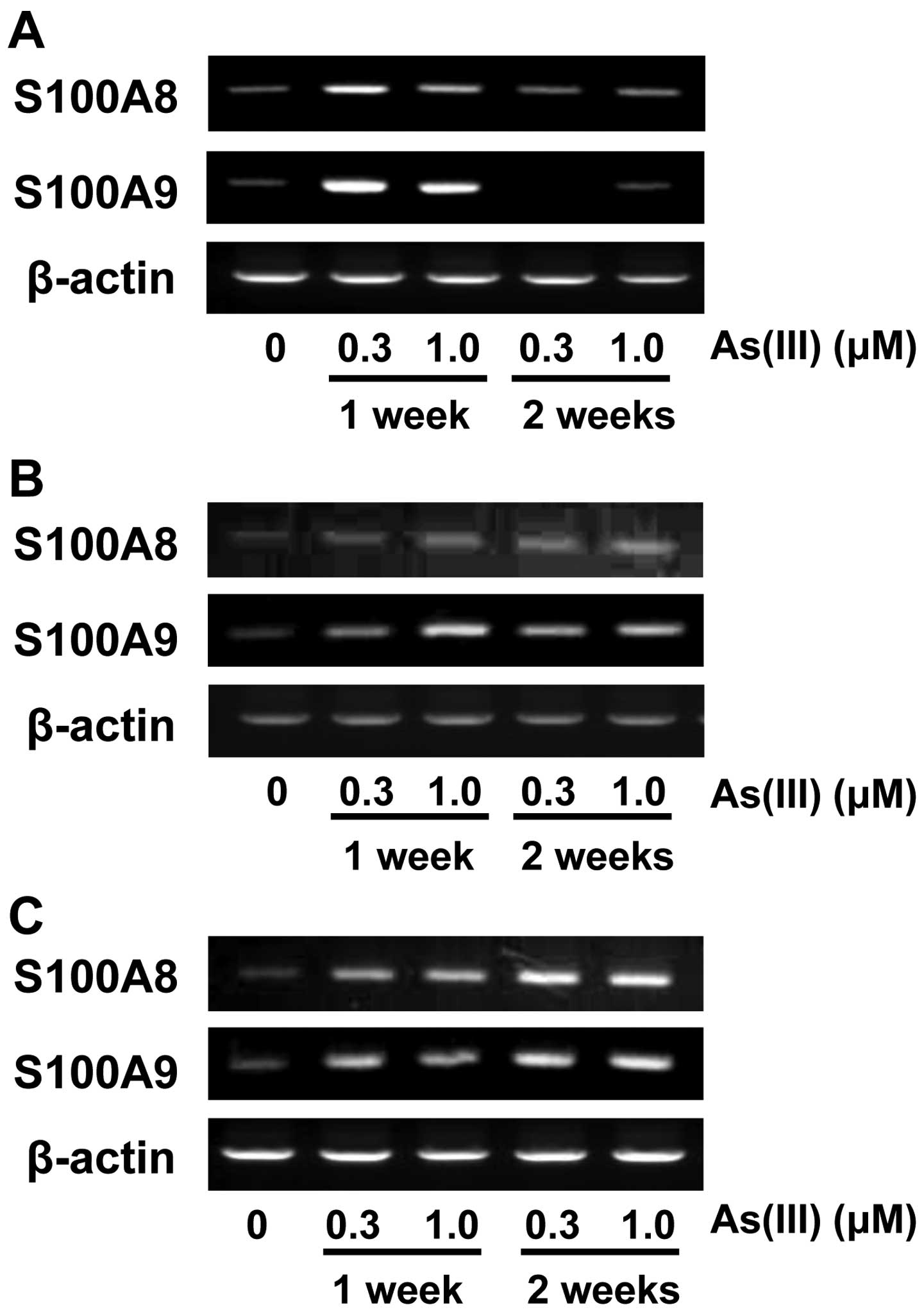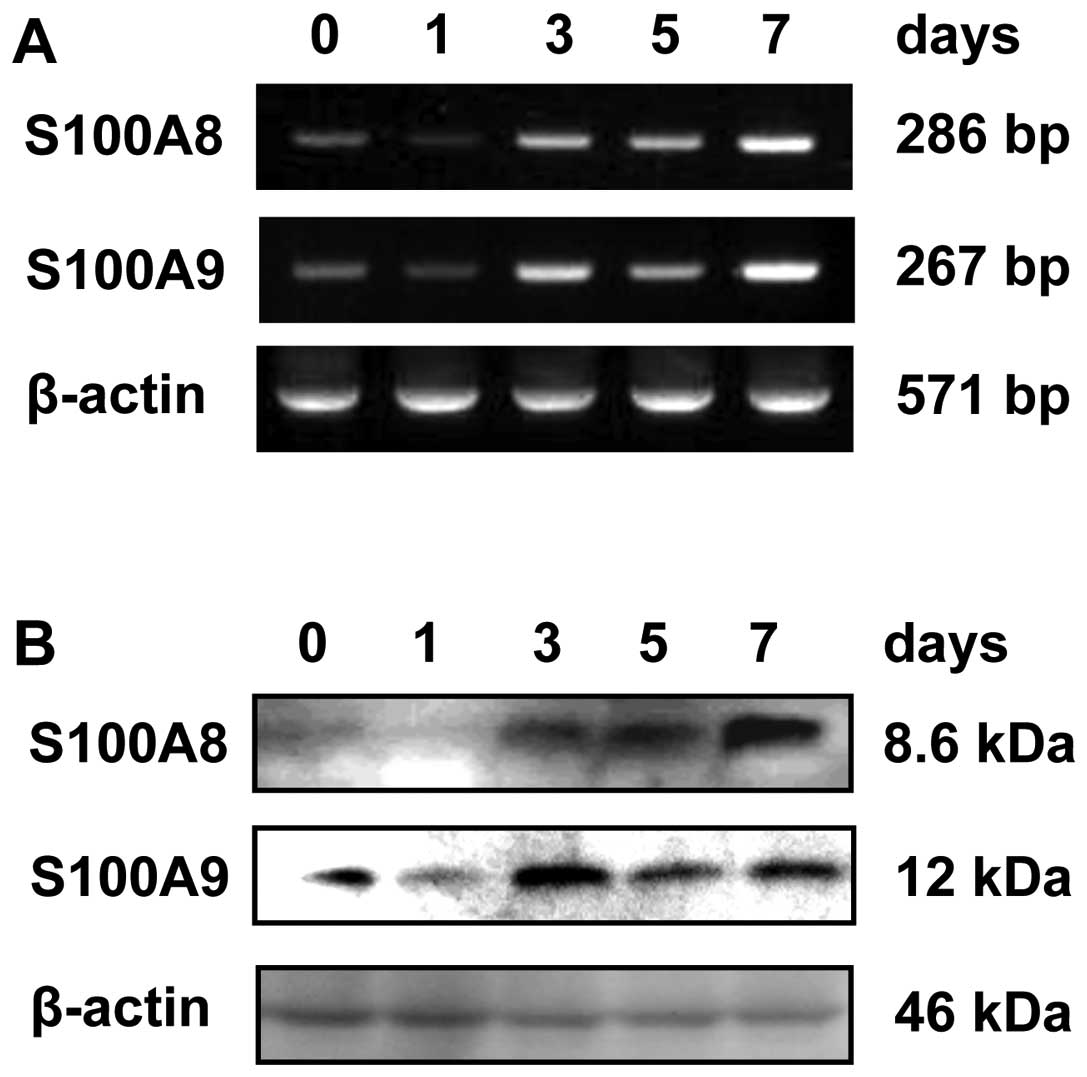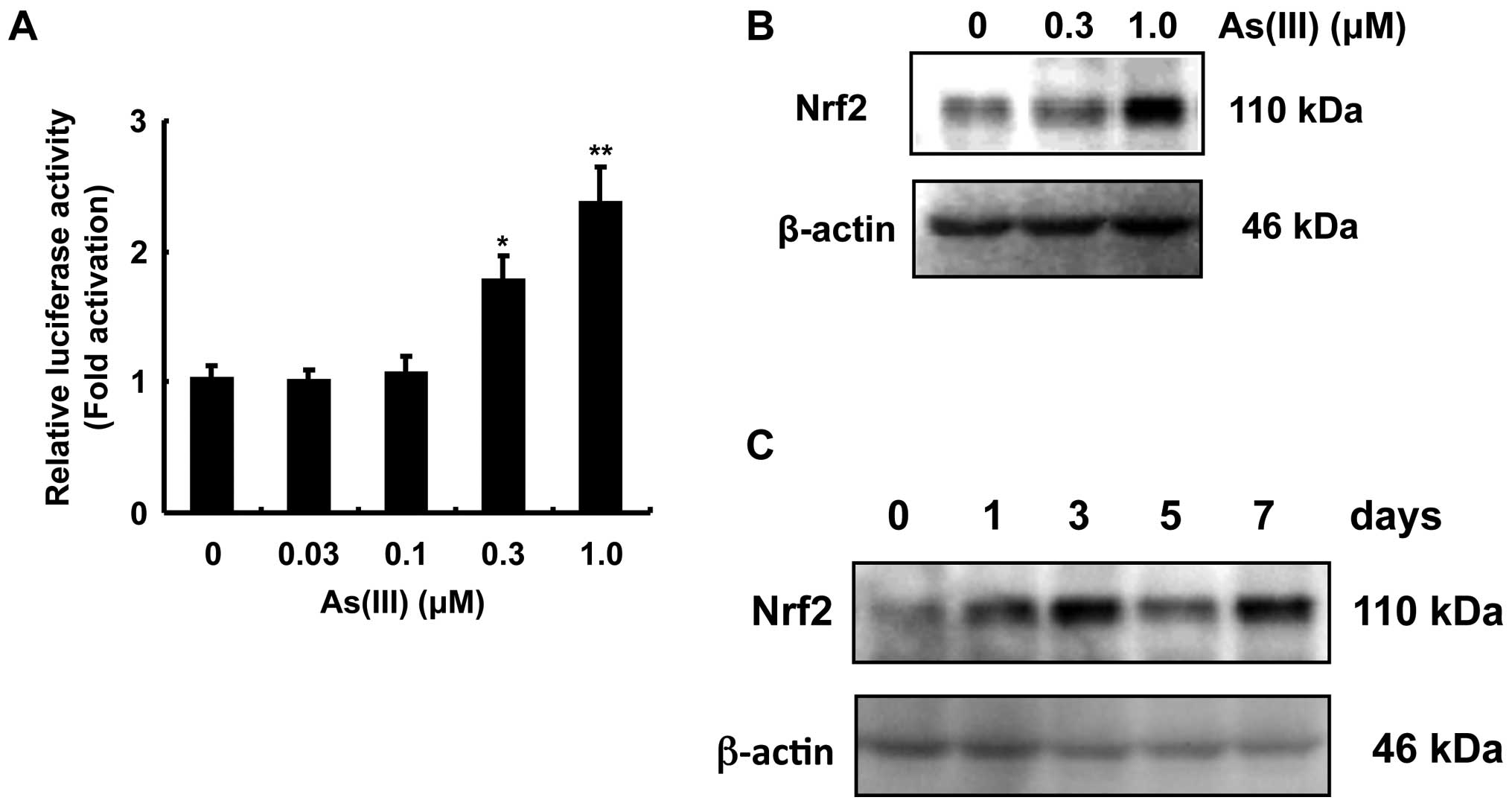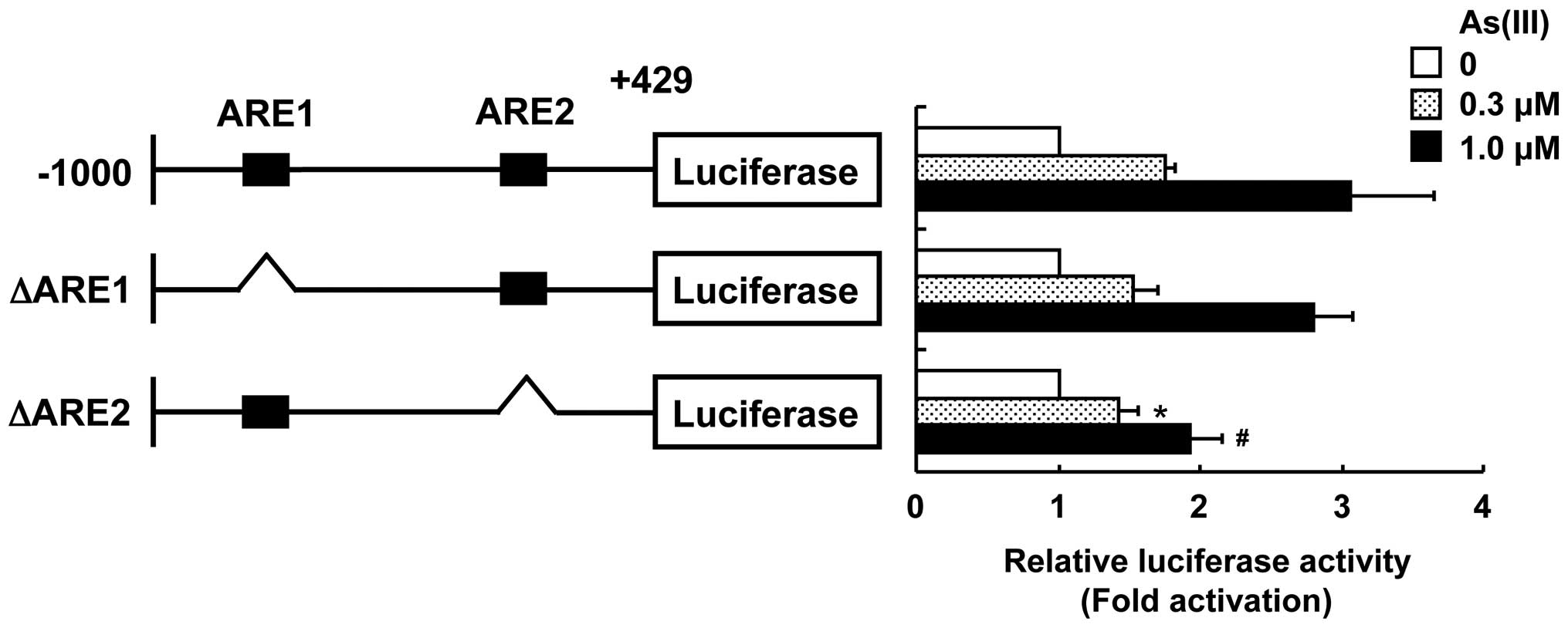Involvement of Nrf2 activation in the upregulation of S100A9 by exposure to inorganic arsenite
- Authors:
- Published online on: November 16, 2012 https://doi.org/10.3892/ijmm.2012.1185
- Pages: 259-264
Abstract
Introduction
Exposure to arsenic as an environmental pollutant is known to increase the incidence of a variety of diseases, including cancer and cardiovascular disease (1,2). At the same time, arsenic is known to disturb the functions of various types of immune cells (3,4), and this disturbance in immunological functions may play a role not only in the etiology of arsenic-associated infectious diseases, but also in cancer and cardio-vascular disease. Although the effects of arsenic exposure on the functions of T cells and macrophages have been examined (4,5), little information is available on the effects of arsenic on mast cells. We previously carried out a microarray analysis by using rat RBL-2H3 mast cells after chronic exposure to inorganic arsenite [As(III)] for 4 weeks. It was found that some S100 proteins, including S100A9, S100A10, S100A6 and S100A13, were upregulated in RBL-2H3 cells after chronic exposure to As(III). Among S100 proteins, the mRNA levels of S100A8 and S100A9 determined by real-time RT-PCR were highly upregulated following a 1- and 2-week exposure to As(III) (6).
S100A8 and S100A9, which comprise a complex called calprotectin, are highly expressed in neutrophils, monocytes and activated macrophages. Accumulating evidence has shown that S100A8 and S100A9 are strongly associated with infection, autoimmunity, cardiovascular disease, and cancer (7,8). The S100A8 and S100A9 proteins possess intracellular and extracellular functions. Intracellularly, the heterocomplex of S100A8 and A9 supports the activation of NADPH oxidase through the interaction with p67phox and Rac2, leading to the enhancement of reactive oxygen species (ROS) formation (9). On the other hand, the excreted calprotectin acts as a ligand for Toll-like receptor 4 (TLR4), leading to the development of autoreactive lymphocytes, and as a ligand for the receptor for advanced glycation endproducts (RAGE) (10,11), leading to the disturbance in vascular functions.
Transcription NF-E2-related factor 2 (Nrf2) is one of the major cellular defense mechanisms against oxidative and/or electrophilic stress (12). The Nrf2 recognizes the antioxidant response element (ARE) in the promoter region of the genes and regulates the basal and inducible expression of numerous antioxidant and detoxifying genes. Kumagai and Sumi (14) reported that arsenicals such as As(III) activate nuclear Nrf2 accumulation, leading to an upregulation of antioxidant enzymes such as heme oxygenase-1 and phase II detoxifying enzymes such as glutathione S-transferase (13). However, whether Nrf2 is involved in trans-activation of the S100A8 and S100A9 genes has not been investigated.
In this study, we found that S100A8 and S100A9 expression are upregulated after exposure to As(III) in skin keratinocyte HaCaT cells, leukemic monocyte U937 cells, and bladder urothelial UROtsa cells. In addition, the results of a study using the S100A9 promoter-dependent luciferase showed that S100A9 upregulation is dependent on the activation of Nrf2.
Materials and methods
Materials
Sodium arsenite (90% purity) was purchased from Wako Pure Chemicals (Osaka, Japan). Antibody for Nrf2 was purchased from Santa Cruz Biotechnology, Inc. (Santa Cruz, CA, USA), and anti-β-actin was purchased from Cell Signaling Technology (Beverly, MA, USA). Anti-S100A8 antibody was purchased from Acris Antibodies GmbH (Herford, Germany). Anti-S100A9 antibody was purchased from Novus Biologicals (Littleton, CO, USA). All other reagents and chemicals used were of the highest grade available.
Cell culture
Human skin keratinocyte HaCaT cells were obtained from Dr Norbert E. Fusenig (15). Human leukemic monocyte U937 cells were purchased from American Type Culture Collection (Manassas, VA, USA). Human urothelial UROtsa cells were obtained from Dr Mary Ann Sens (16). HaCaT and UROtsa cells were cultured at 37°C in a humidified atmosphere of 5% CO2 using Dulbecco’s modified Eagle’s medium (DMEM) containing 10% fetal calf serum, penicillin (100 U/ml) and streptomycin (100 μg/ml). U937 cells were cultured at 37°C in a humidified atmosphere of 5% CO2 using RPMI-1640 (all were from Wako Pure Chemicals) containing 10% fetal calf serum, penicillin (100 U/ml) and streptomycin (100 μg/ml).
Semi-quantitative reverse transcription-polymerase chain reaction (RT-PCR)
Total RNA was isolated from cells using Isogen reagents (Wako Pure Chemicals). A reaction mixture (20 μl) containing RT buffer (Fermentas, Burlington, ON, Canada), dNTPs, oligo(dT)15 primer, RNase inhibitor (Toyobo, Osaka, Japan), M-MuLV Reverse Transcriptase (Fermentas), and 1 μg of total RNA was incubated at 37°C for 90 min followed by inactivation of the enzyme at 65°C for 5 min. For the PCR amplification of cDNA, a 25 μl mixture containing Premix Taq (Takara Bio, Inc., Shiga, Japan), 2 μl cDNA, and the specific PCR primers was prepared. The primer sequences are given in Table I. The PCR reactions were carried out as follows: for S100A8 and S100A9, 1 cycle of 94°C for 5 min, followed by 27 cycles of 94°C for 30 sec, 58°C for 30 sec, and 72°C for 1 min, and a final cycle at 72°C for 7 min; for β-actin, 1 cycle of 94°C for 5 min, followed by 35 cycles of 94°C for 30 sec, 55°C for 30 sec, and 72°C for 1 min, and a final cycle of 72°C for 7 min. The amplified products were resolved by 2% agarose gel electrophoresis.
Western blotting
The total cell lysates were used for western blotting of the proteins. Samples for each analysis were separated by sodium dodecyl sulfate-polyacrylamide gel electrophoresis (SDS-PAGE). Gels were transferred to an Immun-Blot PVDF membrane and then placed in a blocking solution consisting of TBST [10 mM Tris (pH 8.0), 150 mM NaCl, and 0.05% Tween-20] and 5% skim milk for 1 h. The blotted membranes were incubated with the appropriate antibody, washed with TBST, and incubated with HRP-conjugated secondary antibody. The bound IgG was visualized with Western Blotting Detection Reagents (Thermo Scientific, Rockford, IL, USA) according to the manufacturer’s protocol.
Plasmid construction for the S100A9 promoter (−1000/+429)- luciferase
Genomic DNA from HaCaT cells was prepared with a Wizard Genome DNA purification kit (Promega, Madison, WI, USA). For the PCR amplification of the S100A9 promoter region (−1000/+429), a 50 μl mixture containing PrimeSTAR™ Max DNA Polymerase (Takara Bio, Inc.), 200 pg genomic DNA, and the PCR primers 5′-ATGGTACC ATCACTGTGGAGTAGGGGAAGGGCACT-3′ and 5′-GGA GATCTCGTCTTGCACTCTGTCTGTGTAATGGA-3′ (underlined letters indicate the recognition site for the restriction enzymes KpnI and BglII, respectively) was prepared. The PCR reaction consisted of 35 cycles of 98°C for 10 sec, 55°C for 5 sec, and 72°C for 10 sec. Amplified cDNA was cloned using a StrataClone Blunt PCR cloning kit (Agilent Technologies, Palo Alto, CA, USA). The sequenced cDNA of the S100A9 promoter was subcloned into pGL3-Basic (Promega).
Truncation of two ARE sites on the S100A9 promoter to construct ΔARE1 and ΔARE2
To construct deletion mutants of each ARE site on the S100A9 promoter on pGL3-Basic (ΔARE1 and ΔARE2), PCR was carried out with the following primers: for ΔARE1, 5′-GAAGCTGGCCGGACGCCATTC CAAGAGG-3′ and 5′-CCTCTTGGAATGGCGTCCGGCCA GCTTC-3′; and for ΔARE2, 5′-ACTGCTCACCTGTGAA GAAGCAATAGACAGGGCCA-3′ and 5′-TGGCCCTGTCTA TTGCTTCACAGGTGAGCAGT-3′. The deletion mutants were amplified with a QuickChange II Site-Directed Mutagenesis kit (Agilent Technologies) according to the manufacturer’s protocol.
Transient transfection and luciferase assay
HaCaT cells (1.0×105) were seeded in 12-well plates. Transfection was performed with Lipofectamine 2000 (Invitrogen, Carlsbad, CA, USA) according to the manufacturer’s instructions. HaCaT cells were transfected with 1.6 μg S100A9 promoter-luciferase cDNA and 0.16 μg pRL-TK for 24 h. Following exposure to As(III), HaCaT cells were washed with PBS and lysed with Passive Lysis Buffer (Promega). Luciferase activities in the cellular extracts were measured with a Dual-Luciferase Reporter Assay System (Promega). Renilla reniformis-derived luciferase activity was used for the correction of transfection efficiency.
Statistical analysis
Data were obtained from three separate experiments. The values are shown as the means ± SD. Statistical significance was assessed with Student’s t-test. Differences between groups were considered statistically significant at P<0.05.
Results
Effects of inorganic arsenite on S100A8 and S100A9 expression in nine lines of human-derived cells
We previously showed that expression of S100A8 and S100A9 is upregulated by chronic exposure to As(III) in rat RBL-2H3 cells (6). In the present study, we first examined whether As(III) also induces S100A8 and S100A9 expression in other human-derived cell lines, including lung epithelial A549 cells, kidney carcinoma Caki-2 cells, immortalized skin keratinocytic HaCaT cells, embryonic kidney HEK293 cells, liver carcinoma HepG2 cells, immortalized T lymphocyte Jurkat cells, normal human epidermal keratinocytes (NHEK), leukemic monocyte lymphoma U937 cells, and immortalized bladder urothelial UROtsa cells. These cells were exposed to 0.3 and 1.0 μM As(III) for 1 and 2 weeks. Increased levels of S100A8 and S100A9 mRNA were observed in HaCaT (Fig. 1A), UROtsa (Fig. 1B) and U937 cells (Fig. 1C), but not in the other cell types. Since HaCaT cells showed a marked increase in mRNA levels of S100A8 and S100A9 after a 1-week exposure to As(III), we used HaCaT cells in the subsequent experiments. We next examined whether exposure of HaCaT cells to As(III) for 1, 3, 5 and 7 days induces S100A8 and S100A9 expression. The results showed that increased levels of S100A8 and S100A9 mRNA and protein were observed 3, 5 and 7 days after exposure to As(III) (Fig. 2).
Inorganic arsenite enhances the S100A9 promoter activity in HaCaT cells
The expression of S100A8 and S100A9 genes could be regulated in either harmonized or independent ways. Some studies have suggested a more important role of S100A9 than S100A8 (17,18), and cis-elements for trans-activation on the human S100A9 gene have been well documented (19,20). Thus, we focused on the mechanisms underlying S100A9 trans-activation in HaCaT cells exposed to As(III). To investigate whether As(III) activates transcription of the S100A9 gene in HaCaT cells, we measured the activity of luciferase in HaCaT cells transfected with the cDNA of the S100A9 promoter (−1000/+429)-fused to luciferase. As(III) significantly enhanced S100A9 promoter-dependent luciferase activity (Fig. 3A). Since the transcription factor Nrf2 is known to be activated by exposure to As(III), we examined Nrf2 accumulation after exposure of HaCaT cells to As(III). Nrf2 accumulation was detected after exposure to 0.3 and 1.0 μM As(III) for 3 days (Fig. 3B), and 1.0 μM As(III) for the indicated number of days (Fig. 3C).
Nrf2 activation by inorganic arsenite enhances the S100A9 expression in HaCaT cells
We found that two AREs, 5′-ACAGGCAGGG-3′ from −897 to −887 (ARE1) and 5′-ATCTTCCGGAG-3′ from −78 to −67 (ARE2), were present in the S100A9 promoter region from −1,000 to +429. To examine the direct correlation between Nrf2 activation and S100A9 promoter activation in response to As(III), the underlined nucleotides from each ARE region were deleted from the S100A9 promoter (−1,000/+429)-fused luciferase cDNA to construct ΔARE1 and ΔARE2. The deletion of ARE1 did not affect the activation of the S100A9 promoter in response to As(III) (Fig. 4). However, HaCaT cells transfected with the ARE2-deleted S100A9 promoter-fused luciferase cDNA showed a significant reduction in As(III)-induced S100A9 promoter activation as compared with cells transfected with the native S100A9 promoter. These results suggest that Nrf2 activation is involved in the stimulation of S100A9 promoter activity and the ARE2 region is responsible for activation of the S100A9 promoter in response to As(III).
Discussion
We previously showed that S100A8 and S100A9 are upregulated in rat RBL-2H3 mast cells after chronic exposure to As(III) (6). To test whether this induction is restricted to RBL-2H3 cells, nine human-derived cell lines were exposed to As(III). We found that HaCaT, UROtsa and U937 cells have the ability to increase the levels of S100A8 and S100A9 mRNAs upon exposure to As(III) (Fig. 1). This result suggests that the induction of S100A8 and S100A9 expression by As(III) exposure may have a significant role in some of the target cells of arsenic toxicity. Since the keratinocyte-derived HaCaT cells showed a marked increase in mRNA levels of S100A8 and S100A9 after a 1-week exposure to As(III), we used HaCaT cells in the subsequent experiments on trans-activation.
Although the functions of the hetero-dimerized form of S100A8 and S100A9 have been well documented, recent findings have shown that S100A9 rather than S100A8 appears to have a predominant role in immunological responses and inflammation. Indeed, the differentiation of dendritic cells and macrophages was inhibited in S100A9 transgenic mice (17), and anti-S100A9 antibody but not anti-S100A8 antibody reduced trans-endothelial migration of monocytes (18). Thus, we examined the mechanisms underlying S100A9 trans-activation in HaCaT cells exposed to As(III).
It has been reported that exposure to As(III) and inorganic arsenate [As(V)] caused Nrf2 activation and subsequent upregulation of downstream proteins in MC-3T3E osteoblast and HaCaT cells (13,21). Not only inorganic arsenicals, but also organic arsenicals such as monomethylarsonous acid caused Nrf2 activation in RAW264.7 and UROtsa cells (14,22). In Nrf2-deficient cells, the adaptive response to arsenicals was profoundly impaired, leading to the augmentation of arsenic-induced cytotoxicity and oxidative stress (14,23). However, the role of Nrf2 in the expression of S100A8 and S100A9 has not been investigated. Therefore, we explored the involvement of Nrf2 in the activation of the S100A9 gene by exposure to As(III). As a result, Nrf2 activation was detected by accumulation of Nrf2 protein in HaCaT cells exposed to As(III) (Fig. 3B and C). In addition, we found two putative ARE sites (ARE1 and ARE2) for the binding of Nrf2 in the promoter region of the human S100A9 gene. The experiments using ARE deletion mutants showed that ARE2 is the responsive site for As(III)-induced promoter activation of the S100A9 gene (Fig. 4). These results are the first to demonstrate that the induction of S100A9 expression by exposure to As(III) is dependent on the ARE2 region in the S100A9 gene with concomitant activation of Nrf2.
It has been reported that the C/EBP and NF-κB binding sites are the putative cis-elements for trans-activation on the human S100A9 gene (20). These two elements may also be involved in As(III)-induced trans-activation. Lin et al (24) reported that exposure of HaCaT cells to As(III) enhanced the expression of RTP801, which is currently known as a DNA-damage-inducible transcript 4, through the activation of C/EBPβ. On the other hand, NF-κB activation has been reported in aortic endothelial cells exposed to As(III) (25,26). Since our data showed that the ARE2 deletion does not completely block the induction of S100A9-dependent promoter activity by As(III) exposure, C/EBP and/or NF-κB in addition to Nrf2 might also be involved in the As(III)-induced S100A9 transcription. A study with human mature monocytic Mono Mac 6 cells, which exhibit high S100A9 expression under steady-state conditions (20), showed that expression of S100A9 was dependent on the two regions in the promoter of the S100A9 gene, from 153 to 361 (first intron) and from −400 to −374 (promoter region). Additionally, the Kruppel-related zinc finger protein and the transcriptional intermediary factor 1β (TIF1β) were shown to bind to the region from −400 to −374 in the promoter of the S100A9 gene, resulting in the upregulation of S100A9 expression (19,20). Further studies are required to clarify whether the Kruppel-related zinc finger protein and TIF1β are activated by As(III) in HaCaT cells.
Exposure of HaCaT cells to As(III) also increased mRNA and protein levels of S100A8 (Figs. 1 and 2). Xu et al (27) showed that the 178-bp region of the S100A8 promoter is responsible for the lipopolysaccharide-induced increase in S100A8 mRNA in macrophages. Kuwayama et al (28) revealed that the 426-bp region of the S100A8 promoter is essential for the S100A8 induction in differentiated leukemia cells. However, based on our database searches, there have been no previous reports of ARE sites in the essential S100A8 promoter. This suggests that a trans-activator other than Nrf2 is responsible for the S100A8 induction in HaCaT cells exposed to As(III), although further studies will be needed to examine whether Nrf2 is implicated in As(III)-induced S100A8 upregulation.
Kerkhoff et al (9) revealed that S100A8 and S100A9 interact with p67phox and Rac2, the components of NADPH oxidase, resulting in an activation of NADPH oxidase activity. Several lines of evidence have indicated that arsenicals are capable of generating ROS via the activation of NADPH oxidase (29,30). Benedyk et al (31) reported that the HaCaT cells in which S100A8 and S100A9 are overexpressed showed increased NADPH oxidase activity, resulting in an enhanced ROS production. Taken together with these previous findings, our present results raise the possibility that the induction of S100A8 and S100A9 expression may be involved, at least partly, in ROS production through the activation of NADPH oxidase in response to As(III).
The current study is the first to demonstrate that As(III) enhanced S100A8 and S100A9 expression in several lines of human-derived cells and that As(III)-induced S100A9 expression is dependent on Nrf2 activation. Since S100A8/S100A9 is reported to be associated with tumor development and cardio-vascular diseases, the upregulation of S100A8/S100A9 upon exposure to As(III) may play a significant role in the development of the adverse effects of arsenic.
Acknowledgements
This study was supported by a grant-in-aid for Scientific Research from the Ministry of Education, Science, Culture, and Sports of Japan (no. 24310048 to D.S. and no. 22390127 to S.H.).
Abbreviations:
|
As(III) |
inorganic arsenite |
|
Nrf2 |
NF-E2-related factor 2 |
References
|
Engel RR, Hopenhayn-Rich C, Receveur O and Smith AH: Vascular effects of chronic arsenic exposure: a review. Epidemiol Rev. 16:184–209. 1994.PubMed/NCBI | |
|
Tseng WP, Chu HM, How SW, Fong JM, Lin CS and Yeh S: Prevalence of skin cancer in an endemic area of chronic arsenicism in Taiwan. J Natl Cancer Inst. 40:453–463. 1968.PubMed/NCBI | |
|
Kozul CD, Hampton TH, Davey JC, et al: Chronic exposure to arsenic in the drinking water alters the expression of immune response genes in mouse lung. Environ Health Perspect. 117:1108–1115. 2009. View Article : Google Scholar : PubMed/NCBI | |
|
Liao WT, Yu CL, Lan CC, et al: Differential effects of arsenic on cutaneous and systemic immunity: focusing on CD4+ cell apoptosis in patients with arsenic-induced Bowen’s disease. Carcinogenesis. 30:1064–1072. 2009. View Article : Google Scholar : PubMed/NCBI | |
|
Banerjee N, Banerjee S, Sen R, et al: Chronic arsenic exposure impairs macrophage functions in the exposed individuals. J Clin Immunol. 29:582–594. 2009. View Article : Google Scholar : PubMed/NCBI | |
|
Shimizu Y, Fujishiro H, Matsumoto K, Sumi D, Satoh M and Himeno S: Chronic exposure to arsenite induces S100A8 and S100A9 expression in rat RBL-2H3 mast cells. J Toxicol Sci. 36:135–139. 2011. View Article : Google Scholar : PubMed/NCBI | |
|
Ehrchen JM, Sunderkotter C, Foell D, Vogl T and Roth J: The endogenous Toll-like receptor 4 agonist S100A8/S100A9 (calprotectin) as innate amplifier of infection, autoimmunity, and cancer. J Leukoc Biol. 86:557–566. 2009. View Article : Google Scholar : PubMed/NCBI | |
|
Nacken W, Roth J, Sorg C and Kerkhoff C: S100A9/S100A8: Myeloid representatives of the S100 protein family as prominent players in innate immunity. Microsc Res Tech. 60:569–580. 2003. View Article : Google Scholar : PubMed/NCBI | |
|
Kerkhoff C, Nacken W, Benedyk M, Dagher MC, Sopalla C and Doussiere J: The arachidonic acid-binding protein S100A8/A9 promotes NADPH oxidase activation by interaction with p67phox and Rac-2. FASEB J. 19:467–469. 2005.PubMed/NCBI | |
|
Kerkhoff C, Sorg C, Tandon NN and Nacken W: Interaction of S100A8/S100A9-arachidonic acid complexes with the scavenger receptor CD36 may facilitate fatty acid uptake by endothelial cells. Biochemistry. 40:241–248. 2001. View Article : Google Scholar : PubMed/NCBI | |
|
Loser K, Vogl T, Voskort M, et al: The Toll-like receptor 4 ligands Mrp8 and Mrp14 are crucial in the development of autoreactive CD8+ T cells. Nat Med. 16:713–717. 2010. View Article : Google Scholar : PubMed/NCBI | |
|
Itoh K, Tong KI and Yamamoto M: Molecular mechanism activating Nrf2-Keap1 pathway in regulation of adaptive response to electrophiles. Free Radic Biol Med. 36:1208–1213. 2004. View Article : Google Scholar : PubMed/NCBI | |
|
Aono J, Yanagawa T, Itoh K, et al: Activation of Nrf2 and accumulation of ubiquitinated A170 by arsenic in osteoblasts. Biochem Biophys Res Commun. 305:271–277. 2003. View Article : Google Scholar : PubMed/NCBI | |
|
Kumagai Y and Sumi D: Arsenic: signal transduction, transcription factor, and biotransformation involved in cellular response and toxicity. Annu Rev Pharmacol Toxicol. 47:243–262. 2007. View Article : Google Scholar : PubMed/NCBI | |
|
Fusenig NE and Boukamp P: Multiple stages and genetic alterations in immortalization, malignant transformation, and tumor progression of human skin keratinocytes. Mol Carcinog. 23:144–158. 1998. View Article : Google Scholar : PubMed/NCBI | |
|
Rossi MR, Masters JR, Park S, et al: The immortalized UROtsa cell line as a potential cell culture model of human urothelium. Environ Health Perspect. 109:801–808. 2001. View Article : Google Scholar : PubMed/NCBI | |
|
Cheng P, Corzo CA, Luetteke N, et al: Inhibition of dendritic cell differentiation and accumulation of myeloid-derived suppressor cells in cancer is regulated by S100A9 protein. J Exp Med. 205:2235–2249. 2008. View Article : Google Scholar : PubMed/NCBI | |
|
Eue I, Pietz B, Storck J, Klempt M and Sorg C: Transendothelial migration of 27E10+ human monocytes. Int Immunol. 12:1593–1604. 2000. View Article : Google Scholar : PubMed/NCBI | |
|
Kerkhoff C, Hofmann HA, Vormoor J, et al: Binding of two nuclear complexes to a novel regulatory element within the human S100A9 promoter drives the S100A9 gene expression. J Biol Chem. 277:41879–41887. 2002. View Article : Google Scholar : PubMed/NCBI | |
|
Melkonyan H, Hofmann HA, Nacken W, Sorg C and Klempt M: The gene encoding the myeloid-related protein 14 (MRP14), a calcium-binding protein expressed in granulocytes and monocytes, contains a potent enhancer element in the first intron. J Biol Chem. 273:27026–27032. 1998. View Article : Google Scholar | |
|
Pi J, Qu W, Reece JM, Kumagai Y and Waalkes MP: Transcription factor Nrf2 activation by inorganic arsenic in cultured keratinocytes: involvement of hydrogen peroxide. Exp Cell Res. 290:234–245. 2003. View Article : Google Scholar : PubMed/NCBI | |
|
Wang XJ, Sun Z, Chen W, Li Y, Villeneuve NF and Zhang DD: Activation of Nrf2 by arsenite and monomethylarsonous acid is independent of Keap1-C151: enhanced Keap1-Cul3 interaction. Toxicol Appl Pharmacol. 230:383–389. 2008. View Article : Google Scholar : PubMed/NCBI | |
|
Wang XJ, Sun Z, Chen W, Eblin KE, Gandolfi JA and Zhang DD: Nrf2 protects human bladder urothelial cells from arsenite and monomethylarsonous acid toxicity. Toxicol Appl Pharmacol. 225:206–213. 2007. View Article : Google Scholar : PubMed/NCBI | |
|
Lin L, Stringfield TM, Shi X and Chen Y: Arsenite induces a cell stress-response gene, RTP801, through reactive oxygen species and transcription factors Elk-1 and CCAAT/enhancer-binding protein. Biochem J. 392:93–102. 2005. View Article : Google Scholar : PubMed/NCBI | |
|
Barchowsky A, Dudek EJ, Treadwell MD and Wetterhahn KE: Arsenic induces oxidant stress and NF-kappa B activation in cultured aortic endothelial cells. Free Radic Biol Med. 21:783–790. 1996. View Article : Google Scholar : PubMed/NCBI | |
|
Barchowsky A, Roussel RR, Klei LR, et al: Low levels of arsenic trioxide stimulate proliferative signals in primary vascular cells without activating stress effector pathways. Toxicol Appl Pharmacol. 159:65–75. 1999. View Article : Google Scholar | |
|
Xu K, Yen T and Geczy CL: IL-10 upregulates macrophage expression of the S100 protein S100A8. J Immunol. 166:6358–6366. 2001. View Article : Google Scholar : PubMed/NCBI | |
|
Kuwayama A, Kuruto R, Horie N, Takeishi K and Nozawa R: Appearance of nuclear factors that interact with genes for myeloid calcium binding proteins (MRP-8 and MRP-14) in differentiated HL-60 cells. Blood. 81:3116–3121. 1993.PubMed/NCBI | |
|
Shen SC, Yang LY, Lin HY, Wu CY, Su TH and Chen YC: Reactive oxygen species-dependent HSP90 protein cleavage participates in arsenical As(+3)- and MMA(+3)-induced apoptosis through inhibition of telomerase activity via JNK activation. Toxicol Appl Pharmacol. 229:239–251. 2008.PubMed/NCBI | |
|
Smith KR, Klei LR and Barchowsky A: Arsenite stimulates plasma membrane NADPH oxidase in vascular endothelial cells. Am J Physiol Lung Cell Mol Physiol. 280:L442–L449. 2001.PubMed/NCBI | |
|
Benedyk M, Sopalla C, Nacken W, et al: HaCaT keratinocytes overexpressing the S100 proteins S100A8 and S100A9 show increased NADPH oxidase and NF-kappaB activities. J Invest Dermatol. 127:2001–2011. 2007. View Article : Google Scholar : PubMed/NCBI |













